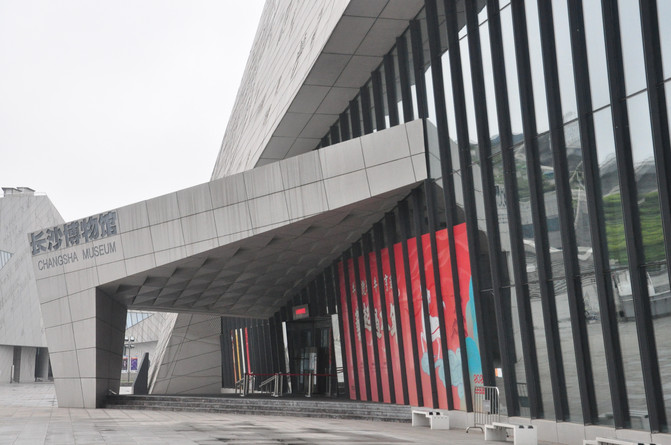Hunan Travel Notes: Changsha Museum
I came out of the Hunan Province Museum at about 1 pm on March 18, 2021 and ate a bowl of noodles on the roadside outside the door. At 1:45, I took the No. 2 bus at Xiangya Crossing to Beichen Bus Station. Get off and cross an overpass, which is the Changsha City Museum. Remember one rule: visit the museum on rainy days.
The new museum of Changsha City is located in the Xinhe Delta Riverside Cultural Park in Kaifu District, Changsha City, Hunan Province. On December 28, 2015, after years of preparation and construction, the New Changsha Museum was completed and opened to the public with a new look.
The shape of the Changsha Museum's LOGO is transformed from the image of the Shang Dynasty bronze cymbal with elephant patterns, the treasure of the town museum, which means that the museum is a palace that preserves and displays historical material culture and memory. At the same time, like the initials "M" of "Museum" in English, it means that modern museum construction and cultural dissemination must be internationalized and create a concept of international quality.
From the appearance, the Changsha Museum is like an open door. Its geographical location is at the intersection of the Xiangjiang River and the Liuyang River. The cultural context of the two Huxiang cultures intersect here. History and the present gather here, opening the door to exploring civilization and growing wisdom. Changsha Museum strives to become one of the new symbols of Huxiang culture.
The new building has a floor height of 5 floors, a total area of 24,000 square meters, a display area of more than 9000 square meters, and a collection of nearly 50,000 cultural relics. Among them, Shang and Zhou bronzes, Chu and Han cultural relics, and Changsha kiln porcelain have attracted attention at home and abroad.
The four exhibition halls on the first and second floors of the museum display basic displays. The exhibition follows historical development and relies on 2000 precious cultural relics to show Changsha's ancient and modern history and tell the stories of Changsha people themselves. The current two basic displays are:
Xiangjiang River to the North--Changsha Ancient History and Culture Exhibition
Changsha is a city that prospered due to its cultural destiny. After Qu Jia surrendered, many sages arrived, famous people gathered, and talents emerged in large numbers. Be honored as the "Hometown of Qu Jia, Xiaoxiang Zhusi" and promote the situation that "Chu is the only talented, but it is prosperous here". The Huxiang culture formed over thousands of years has created Changsha's humanistic feelings of "worrying about the world and daring to be the first". "Xiangjiang River North-Changsha Ancient History and Culture Exhibition" will take you to appreciate Changsha's past.
Midstream hits water--Exhibition of modern history and culture in Changsha
After the Opium War, Tao Shu, He Changling, Wei Yuan and other worldly sages who left the Yuelu Academy looked at the world and issued the cry of the times: "Learn from the barbarians and develop their skills to control the barbarians." Zeng Guofan, Zuo Zongtang, Guo Songtao and others attempted to force wealth and founded Westernization, which promoted the historical process of China's modernization. Tan Sitong, Tang Caichang and other reformers led the New Deal, participated in the reform, and recommended Xuanyuan with blood. Huang Xing, Song Jiaoren and other founding fathers of 1911 founded the Huaxing Society and jointly formed an alliance to overthrow the imperial system and create the Republic of China, taking great credit. Revolutionary leaders such as Mao Zedong, Cai Hesen, He Shuheng, and Liu Shaoqi, with the great ideal of "transforming China and the world" in mind, actively explored new paths for the Chinese revolution, and created the grand cause of establishing the Communist Party of China and creating the People's Republic. "Mid-stream hits the water-Exhibition of Changsha's modern history and culture" will let you feel the magnificent century-old Changsha.
There are also two special exhibition halls on the second floor of the museum. Among them, the Longxiang Jiutian-Special Exhibition of Imperial Porcelain of the Yuan, Ming and Qing Dynasties displays 128 archaeological data and masterpieces of imperial dragon patterns that spanned the Yuan, Ming and Qing Dynasties for 650 years and passed down from generation to generation. Among them, 42 are complete pieces and 60 are restored pieces. There are 26 specimens, with a relatively complete chronological sequence, focusing on reflecting the characteristics of the times, changing rules, and other cultural relics connotations of imperial dragon pattern porcelain of the Yuan, Ming and Qing Dynasties. From the perspective of royal porcelain, we hope to showcase the rich social connotation of China's "dragon culture" and a glimpse of the national totem aesthetics, and at the same time get a glimpse of the "royal porcelain". Another special exhibition of early calligraphy and paintings by Zhang Daqian and Pu Xinyu in the south and Pu Xinyu, flashed past because they had seen it in other museums.
It was already 4:20 p.m. after watching the exhibition, I left the exhibition hall and went to Beichen Delta Station of Metro Line 1. At 4:40, I took Metro Line 1 and then transferred to Line 2 to Juzizhoutou, ready to enjoy the night view of Juzizhoutou at night.





































Previous Article:"Initial S" Regional Test Drive Challenge Changsha Station launches Haval H6S showcases its unique corner attack skills
Next Article:Qiaokou Fishing Capital is a place specializing in eating, fishing and playing fish
